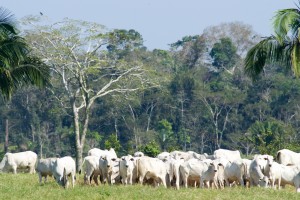 Ever since the UN released the Livestock: The Long Shadow report in 2006, the impact that animal food production has on the planet’s climate has become a staple of any conversation related to the environment. The report estimated that animal farming accounts for around 18 percent of all emissions, due to several factors involved, from deforestation to the use of fertilizers.
Ever since the UN released the Livestock: The Long Shadow report in 2006, the impact that animal food production has on the planet’s climate has become a staple of any conversation related to the environment. The report estimated that animal farming accounts for around 18 percent of all emissions, due to several factors involved, from deforestation to the use of fertilizers.
Last month, the UK’s Institution of Mechanical Engineers (IME) released a new report called Global Food: Waste Not, Want Not, in which the organization also highlighted the inherent resource wastefulness that animal agriculture entails. It said that “an increase in animal-based production†– as it expected with population rise and increasing demand from emerging markets – “will require greater land and resource requirement, as livestock farming demands extensive land use. One hectare of land can, for example, produce rice or potatoes for 19-22 people per annum. The same area will only produce enough lamb or beef for only one or two people.â€
Animal agriculture also demands much more water. As the UN report said and the new report confirms, the production of beef uses around 50 times more water than vegetables. “You can’t put a lot of salt water onto crops. It needs to be relatively good, pure water, and it is hugely wasteful. And unfortunately one of the realities is that the more meat that we eat, and meat is becoming more popular around the world as a food, the more water we have to put on for the same number of peopleâ€, said Dr. Colin Brown, IME’s engineering director.
The wastefulness of animal food production is easy to picture when we find out that it takes 35 calories to produce every calorie of beef consumed. On the other hand, it only takes three calories of energy to produce one calorie of plant-based food.
Granted, there are many other factors that contribute to food production’s high energy footprint, such as the use of fertilizers, pesticides, current models of food distribution, consumer habits and regulations that favor waste. The Institution makes some recommendations in that respect. It says the UN Food & Agriculture Organization should work with the international engineering community to help introduce better technologies in developing countries. It adds governments should improve infrastructure and storage facilities. Finally, consumer expectations should also be changed.
What is clear is that there just isn’t enough space for current levels of meat consumption. Humans currently use about 4.9Gha of the useable 10Gha of land available. It is impossible to increase land usage without impacting on other eco-systems. If we increase animal agriculture that certainly will be the case, as it is already happening in the Amazon, where livestock accounts for 70 percent of all deforestation.
IME recommends changing dietary patterns in the world, mostly in the consumption of meat, to produce an impact on how much food we can produce in the land available. One hectare of land can, for example, produce rice or potatoes for 19 to 22 people per year. The same area will produce enough lamb or beef for only one or two people.
Consumers can help by planning their meals more carefully and switching to a plant-based diet. People who live in developed countries, where most food wastage takes place, should find it relatively easy to do so. This year’s World Environment Day’s Theme is Think.Eat.Save – Reduce your foodprint! and crossing off animal products from the shopping list is a sure way to do that. The web is crammed with websites providing ideas and recipes for a lighter, ethical and healthier diet. All it takes is some mindfulness and creativity.
Sponsored video:





